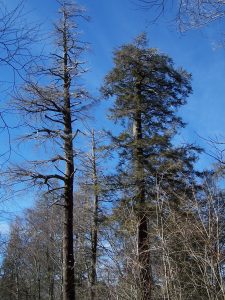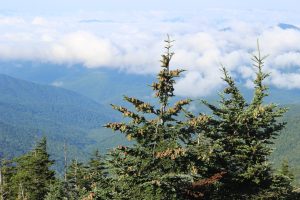Domestic Conservation
In 2003, Camcore began a collaboration with the USDA Forest Service to make seed collections of endangered and threatened forest tree species within the United States. Currently, we have active projects with eastern and Carolina hemlock, red spruce, Fraser fir, Atlantic white cedar, Table Mountain Pine, and two species of Ash. All of our USA-based conservation projects are funded by grants from USDA Forest Service.

Hemlock
Our first domestic projects focused on the conservation of eastern hemlock (Tsuga canadensis) and Carolina hemlock (T. caroliniana). Both are ecologically important species native to the eastern United States and have experienced widespread decline due to infestations of an invasive insect pest named hemlock woolly adelgid, Adelges tsugae (HWA). Our work with hemlock has addressed a number of important topics including genetic resource conservation, population genetics, ecological modelling, host resistance screening, seed technology, nursery production, tree and insect responses to environmental conditions, conservation assessment, and silvicultural options for hemlock restoration. Our initial seed collections occurred in 2003 and have continued annually through 2015, resulting in the acquisition of material from 733 mother trees in 73 populations of eastern hemlock and 134 mother trees in 19 populations of Carolina hemlock.
Our genetic conservation work with hemlock also includes the establishment of conservation banks and seed orchards and in 2015 we had seed production in our Carolina hemlock orchard at the NCSU Upper Mountain Research Station in western North Carolina. This is a significant milestone, and we hope to replicate this in our other Camcore domestic conservation projects
In 2014, we began a proposed long-term, 3-phase cooperative research project with the USDA Forest Service (USFS) to develop a hemlock restoration strategy to reintroduce hemlocks to southern Appalachian forests. The initial work of Phase 1 was done in partnership with USFS Research Entomologist Albert “Bud” Mayfield, and was funded by a $50,000 grant from the USFS. The topic of how to reintroduce hemlocks into forests where they have been lost has received almost no attention. Although HWA-resistant native hemlocks are not yet available and biological, chemical, and integrated control is still developing, restoration protocols should be developed in advance so that seedlings can be rapidly and properly established once they can survive long term. The objectives of the study are:
Phase 1 (current): Develop an optimal silvicultural establishment method for Eastern hemlock.
Phase 2 (future): Develop an integrated biological/chemical control strategy on the hemlocks from Phase 1. Establish new, local-source Eastern and Carolina hemlock restoration plots.
Phase 3 (future): Use Phase 2 results to optimize biological/chemical control on local-source hemlocks.

Fraser Fir and Red Spruce
Fraser fir (Abies fraseri) and red spruce (Picea rubens) are found at high elevations in the southern Appalachian Mountains, where they have seen dramatic reductions in numbers due to overharvesting, wildfires, climate change and atmospheric deposition. Since the 1950’s, Fraser fir has also been threatened by infestations of the exotic insect balsam woolly adelgid (Adelges piceae).
When beginning our work with Fraser fir, we identified the seven known natural populations of the species. The two largest of these populations were further broken down into seven smaller subpopulations for a total of 12 populations spread across North Carolina, Tennessee, and Virginia. From each of these populations Camcore is attempting to collect seed from between 10 to 20 trees. The 2015 collection, combined with seed from 30 trees donated to Camcore in 2014 by the North Carolina Christmas Tree Growers Association Cooperative Seed Orchard brings our total to 129 individual mother trees conserved.
In addition to collecting cones, we are sampling foliage from nearly all of our mother trees. Foliage samples have been sent to the National Forests Genetics Laboratory in Placerville, California where DNA will be extracted. Genetic information from this material will help us to better understand patterns of diversity of the species while allowing us to evaluate the effectiveness of our conservation efforts.
Our work with red spruce in the southeastern United States has significant overlap with Fraser fir. Southern populations of red spruce are found only at the highest elevations in this portion of its range and coincide with Fraser fir habitat. To date, we have collected cones from 83 trees at 12 red spruce sites visited. Of the 83 red spruce trees sampled, 10 were collected by volunteers with Warren Wilson College and the western North Carolina nonprofit Mountain True. Future collections of red spruce will focus on populations in the Black Mountains of North Carolina as well as sites in the under-sampled states of Virginia and West Virginia. Similar to the Fraser fir collections, we sampled foliage from each of the cone trees for eventual DNA extraction by the National Forests Genetics Laboratory.
Atlantic White Cedar
Atlantic White Cedar (AWC, Chamaecyparis thyoides) is a primarily coastal species found in the eastern United States from Maine south to the Gulf Coast states of Florida, Georgia, and Mississippi. Overharvesting, wetland drainage for agriculture and development, and wildfires have reduced natural AWC populations to 20 percent of the area they once occupied.
Using climatic mapping software, we divided the species range into four separate seed zones. In total, we have now conserved material from 205 trees in 28 populations spread across the four different seed zones. In addition to seed, we are collecting foliage from populations visited throughout the range of the species. All foliage samples are sent to the USDA Forest Service National Forest Genetics Lab in California for a genetic diversity study to better understand patterns of genetic structure across the species’ range.
Table Mountain Pine
Camcore worked with Table Mountain pine (Pinus pungens, TMP) from 2009 through 2015. TMP is endemic to the central and southern Appalachian Mountain regions of the eastern United States where natural populations are threatened by wildfire suppression, periodic bark beetle outbreaks, and climate change. Through five field collection seasons, Camcore acquired seed from 262 mother trees distributed across 38 populations. In total, 390,530 seeds were collected for conservation; this represent the largest genetic resource for TMP that exists outside of natural stands. Seeds were distributed as follows: 193,395 seeds representing 242 mother trees and 36 populations reside at the USFS Ashe Nursery Facility for use in seed orchard and reforestation activities; 55,828 seeds representing 257 mother trees and 38 populations have been placed into cold storage at the USDA National Center for Genetic Resources Preservation for long-term conservation; and 135,361 seeds representing 262 mother trees and 38 populations have been retained by Camcore for conservation and research activities.
In addition to seed conservation, Camcore and the USFS are also collaborating on a genetic diversity study of TMP. The objectives of this project are to describe patterns of genetic structure and diversity in natural stands and the seed sample, and to use this data to assess if Camcore’s seed collection efforts did a good job of representing the genetic diversity of the species.
Ash
In late 2015, Camcore began working on a new genetic resource conservation project in the United States focused on species of ash trees, members of the family Oleaceae and the genus Fraxinus. This genus is comprised of 43 species that are widely distributed across North America and Eurasia. Four of these species, Carolina ash (F. caroliniana), pumpkin ash (F. profunda), blue ash (F. quadrangulata), and Texas ash (F. texensis) have more limited distributions and are considered rare species.
Ash trees are an important source of hardwood timber that is valued for its hardness and resilience and is utilized for tool handles, furniture, baseball bats, and other products where wood of superior strength is important. They are also highly valued as landscape trees, planted widely for shade and ornamental purposes. From an ecological perspective, ash trees provide a number of ecosystem services including thermal cover, forage, and nesting sites for associated fauna, and have been widely utilized for the reclamation of surface mine sites in the coal producing regions of the United States.
Ash species native to North America face a significant threat from the emerald ash borer, Agrilus planipennis (EAB), an invasive wood boring beetle native to China that was introduced sometime before 2002. Since its first detection in 2002 in urban forests surrounding Detroit, EAB has spread to 25 US states and 2 Canadian provinces and has killed trees numbering in the tens of millions. Despite significant research and development efforts in chemical and biological control against EAB, the invasion continues unabated and its distribution is spreading at an alarming rate.
The best long-term solution to EAB and the restoration of lost ash forest resources is the breeding and deployment of EAB-resistant planting stock, and in particular the development of resistant genotypes through interspecific hybridization. Given the speed at which EAB continues to spread in North America and the number of trees already killed, it is critical that steps be taken immediately to conserve the genetic resources of native ash species so that they are available for future breeding and restoration efforts.
Camcore’s work on ash genetic resource conservation is funded by a $42,000 grant from the USDA Forest Service (USFS), and is a collaboration with USFS Southern Region Geneticist Barbara Crane. The project will focus on the four rare ash species mentione above. The project objectives are to collect seed from across the native ranges of the species, and to conserve the seed for genetic research and species restoration.

